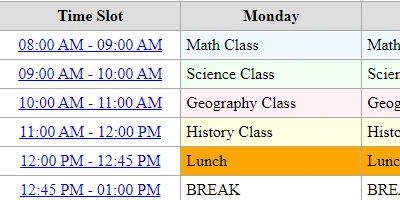Introduction to Weekly Schedule Calendars in SharePoint
A weekly schedule calendar is a powerful tool for visualizing your schedule in a concise and user-friendly format. When integrated with SharePoint, it enhances team collaboration by making it easier to plan and track events. Whether you're managing a team or seeking to better streamline operations, a well-organized calendar can be a game changer.
Charting, Visual Status Indicators, and Project Management
Weekly schedule calendars fit seamlessly into the realm of charting and visual status indicators. They provide stakeholders with a clear snapshot of what's happening in the week. Traditionally, project management relied heavily on Gantt charts and task lists, which, while effective, can be too detailed for daily use. In contrast, a calendar view emphasizes immediacy and ease of understanding.
Visual status indicators, such as color-coded categories within the calendar, offer at-a-glance insights. For example, meetings may be highlighted in blue, deadlines in red, and team events in green. This intuitive design aids in reducing cognitive load, allowing team members to quickly identify priorities without digging through lengthy reports.
Employee Management and Tracking
In terms of employee management and tracking, a weekly schedule calendar serves multiple roles. It can be used to manage shifts, track leave, and ensure overlap of skills on the floor. By setting up a shared calendar, team leaders gain real-time visibility over who is available, who might be overbooked, and how to best allocate resources.
Additionally, integrating this with SharePoint allows for comprehensive tracking. With the right permissions, employees can update their availability, and managers can instantly reflect those changes in team schedules. This keeps everyone aligned and reduces the risk of scheduling conflicts.
Setting Up in SharePoint Using Templates from SharePointDashboards.com
Setting up your weekly schedule calendar in SharePoint is remarkably straightforward, especially with tools like those at
SharePointDashboards.com. Using a simple copy and paste approach, you can integrate the calendar template into your SharePoint site within minutes.
Start by accessing the template database on SharePointDashboards.com, where you can choose from a wide range of calendar styles and formats. The simplicity lies in the pre-made templates that require no technical expertise. By selecting a template, copying the code, and pasting it into your SharePoint list, you instantly apply a professional calendar layout without the need for extensive customization.
Applying SharePoint JSON Formatting
SharePoint JSON formatting plays a vital role in customizing views in your SharePoint list. By applying a JSON template to your list view, you transform standard list data into a visually engaging calendar display.
A JSON template defines the look, feel, and behavior of SharePoint components, enabling you to replicate the stylized calendar. For those unfamiliar, JSON (JavaScript Object Notation) is a lightweight data-interchange format that is easy to read and write. When applied, it dynamically formats your data to present it in a way that aligns with your organizational needs.
Use Cases for Enhanced Status and Progress Demonstration
There are countless scenarios where a weekly schedule calendar can enhance clarity and efficiency:
- Project Management: Coordinating the availability of project team members and aligning their schedules ensures important milestones are not missed.
- Event Planning: Organizing events or company-wide initiatives benefits from clear visibility of dates and alignment of cross-department teams.
- Resource Allocation: Ensuring resources are effectively deployed by tracking who is engaged where and addressing potential overlap or shortages.
- Training Schedules: Managing new recruits' training agendas by having a week-by-week breakdown of training modules and sessions, allowing trainers to efficiently manage time.
- Remote Work Coordination: As remote work becomes more prevalent, having a centralized calendar accessible to all helps in aligning team efforts irrespective of location.
Conclusion
In the evolving landscape of project and employee management, the integration of a weekly schedule calendar within SharePoint offers significant advantages in terms of clarity, efficiency, and real-time collaboration. Access to customizable templates, such as those available at SharePointDashboards.com, makes it easy for organizations to adopt this system without requiring technical expertise. By highlighting tasks and color-coding events, these calendars become a pivotal part of how teams operate, track progress, and ensure that everyone remains on the same page. With tools like JSON formatting, any organization can further tailor their calendar displays to fit specific requirements, ensuring that their workforce is informed, aligned, and productive. Explore the possibilities at
SharePointDashboards.com and revolutionize your scheduling approach today.






